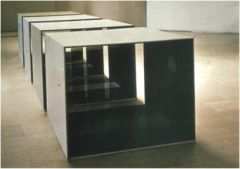Neshat
Turbulent, 1998
- Race, gender.
- Male/female identity. How they are viewed In Western and Iranian culture.
- Reverential exploration of Islamic traditions
- White and black binary. Highlighting differences.
- Man singing a love poem. Woman guttural sounds, etc.
- Male has audience, woman does not.
- Comparison: Karawane, 4’ 33’
Edward Burtynsky
Shipbreaking #49, Chittagong, Bangladesh, 2001
- Metaphor for modern existence
- Ships pushed up on shore and broken apart to sell for scrap.
- Same as whale carcasses on beaches
Takashi Murakami
Eye Love Superflat, 2003
- Incorporates Japanese manga figure eyes
- Taken design to fine art level
- “The Warhol of Japan”
- Flatness of image refuses to engage viewer. Illusionistic depth. Society is flat
Ai Weiwei
Coloured Vases, 2003 – 10
- Speaks out against government and its policies. Calls attention to the working individual. Harm inflicted by the Chinese authority.
- Celebrated in West as artist shaking up China.
- Dips into industrial house paint and allows it to drip.
- Choices of how much to use, what colour.
- Questioning originality. Taking ancient object and changing it. Questioning cultural values. Graphic designs peak through the vases.









































